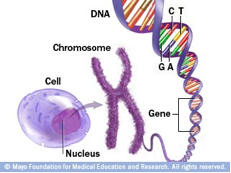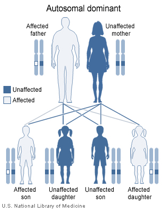Genetics Overview

To understand the genetics of Huntington's disease (HD), it helps to start with some basic genetics: Our bodies are made of cells, and each cell (except red blood cells) carries our genetic material in the nucleus. This genetic material is the “recipe” or “blueprint” that tells the cells how to make each one of us.
Our DNA contains all of our genes, and our genes make proteins that create and determine every aspect of our bodies, from the chemicals that help us digest our food, to our hair color, skin color, and whether or not we will develop HD. Our DNA is packaged into structures called chromosomes that we can see under a microscope.

Each of us has 46 chromosomes which come in pairs. One chromosome of each pair comes from each of our parents. This means that 23 chromosomes come from our mother, and 23 chromosomes come from our father.
We know that the gene which causes HD is on chromosome 4 and that it makes a protein called “huntingtin.” People with HD have one copy of the HD gene that does not function correctly and expresses itself more strongly or 'dominates' the other normally functioning gene.

Huntington's disease is dominantly inherited, which means that people with HD have a 50 percent risk of passing it on to each of their children. Although the illustration at right shows the 50 percent risk, this doesn’t mean that if a person with HD has 4 children, 2 will inherit the condition and 2 won’t. The 50 percent risk is for each child.
So in the case of an HD parent with 4 children, all 4 children could inherit the gene, or 3 of them, or 2, or 1, or none at all. It’s like flipping a coin each time a person with HD has a child. Males and females both have the same 50 percent risk of inheriting the condition from a parent who has HD.
For more information about HD genetics and testing, please see the following pages:
- The Huntington Gene
- Testing Issues in Huntington's Disease
- Diagnostic testing
- Pre-symptomatic testing
- Reproductive Options in HD
- Genetic Testing Insurance Issues

